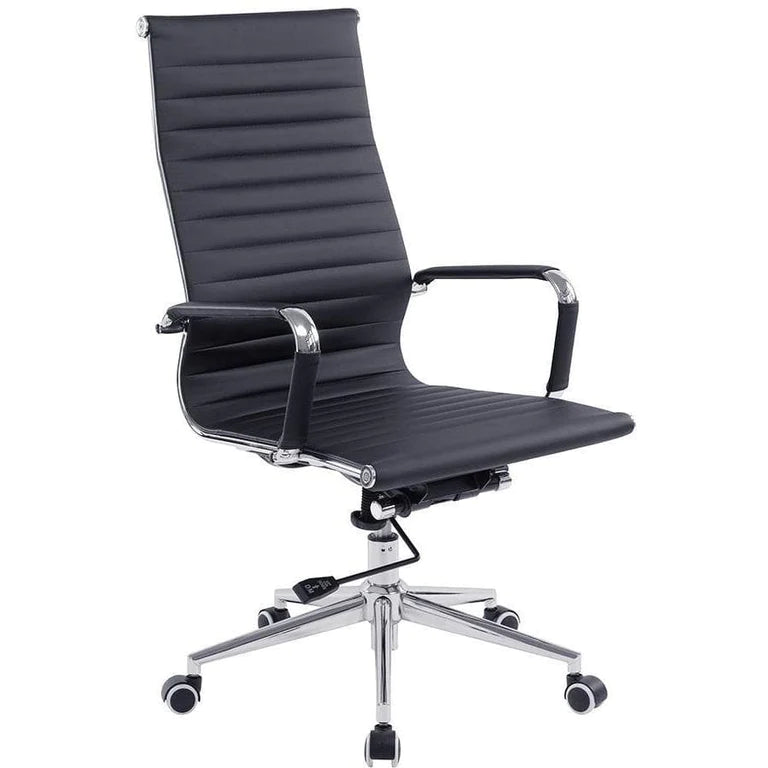
The Complete Guide to Office Ergonomics

Introduction to Office Ergonomics
In today's digitized world, the traditional office environment has undergone significant changes. The landscape of work is now characterized by technology and comfort, which, while enhancing productivity, also comes with its unique set of challenges. One such challenge, often overlooked, is ergonomics - a key determinant of the health, well-being, and productivity of office workers.
Ergonomics, derived from the Greek words 'ergon' meaning work, and 'nomoi' which stands for natural laws, is a science that matches job demands with the capabilities of the working population. Office ergonomics, in particular, focuses on the design and arrangement of office workplaces, keeping in mind the physical and psychological capabilities and limitations of the workers. It seeks to ensure a healthy, comfortable, and efficient work environment.
Why is office ergonomics so essential, you might ask? The answer lies in the fundamental changes that our bodies undergo when subjected to the office routine. Long hours of sitting, constant exposure to computer screens, repetitive motions, and incorrect postures have become commonplace in our work life. These conditions, when left unchecked, can lead to numerous health problems ranging from musculoskeletal disorders, eye strain, and mental stress, to chronic conditions such as obesity, heart disease, and even diabetes.
Key elements of office ergonomics encompass the correct setup of computer workstations, which includes factors such as desk height, monitor position, chair adjustment, keyboard and mouse placement, and the arrangement of other office tools. But office ergonomics isn't confined to physical attributes alone; it also includes aspects like lighting, noise, temperature, and even work practices and routines.
Good office ergonomics aims to adapt the job to fit the person, rather than forcing the person to fit the job. This means designing tasks, workspaces, controls, displays, tools, lighting, and equipment to fit the worker’s physical capabilities and limitations. This practice can significantly reduce the risk of work-related injuries, enhance employee engagement, boost productivity, and promote overall health and wellbeing.
As we navigate the dynamic landscape of work, integrating office ergonomics into our daily work life can serve as a potent tool to balance health and efficiency. As such, a solid understanding of office ergonomics is a vital first step towards a safer, healthier, and more productive workspace. There are some common misconceptions regarding office ergonomics, make sure you don't fall into them.
The Importance of Office Ergonomics
In today's world, where the line between work and home becomes increasingly blurred, the importance of office ergonomics cannot be overstated. Ergonomics, particularly in the office setting, plays a crucial role in maintaining the health and productivity of workers. It holds the potential to transform a potentially hazardous workspace into a safe, comfortable, and productive environment.
Here's why office ergonomics is so vital:
Health Protection
Poor ergonomic practices can lead to severe physical strain and discomfort, resulting in conditions like Carpal Tunnel Syndrome, Tension Neck Syndrome, and lower back injuries. By providing an ergonomically sound workspace, the risk of developing these occupational diseases is significantly reduced. It aids in maintaining the wellbeing of employees, thereby contributing to a healthier workforce.
Increased Productivity
Office ergonomics is directly linked with employee productivity. An ergonomically optimized workspace allows for comfortable positioning and fluid movements, which reduces unnecessary strain and prevents fatigue. This directly translates into more efficient work output and a higher quality of work.
Enhanced Employee Engagement
Investing in office ergonomics shows that the organization values the health and wellbeing of its employees, which can significantly boost morale and job satisfaction. A comfortable working environment is likely to enhance employee engagement, decrease turnover, and promote a more harmonious workplace.
Reduction in Costs
While the initial investment in ergonomic furniture and equipment might seem high, the long-term benefits significantly outweigh the costs. Reduction in medical claims, lower absenteeism, and increased productivity all contribute to the overall cost-saving benefits of implementing ergonomics in the office.
Legal and Regulatory Compliance
Many countries have regulations in place to ensure the health and safety of workers, and these often include ergonomic considerations. By focusing on office ergonomics, companies not only provide a better work environment for their employees but also stay in compliance with health and safety laws and regulations.
Improved Quality of Life
Office ergonomics extends beyond the workplace. The principles learned can be applied to many other areas of life. Improved posture, better work habits, and increased awareness of physical wellbeing can all contribute to an overall better quality of life.
Read in more detail about why office ergonomics matter.
The Risks of Poor Ergonomics
As we delve into the importance of office ergonomics, it's equally crucial to understand the risks associated with poor ergonomic practices. Neglecting ergonomics in the workplace can lead to a myriad of health issues and productivity challenges, with potentially significant ramifications for both employees and organizations.
Here are the main risks associated with poor ergonomics:
Musculoskeletal Disorders (MSDs)
Poor ergonomics often result in repetitive strain and overexertion, which can lead to musculoskeletal disorders. These include conditions like carpal tunnel syndrome, tendonitis, muscle strains, and lower back injuries. MSDs are often characterized by pain, numbness, and reduced motor function, impacting a worker's ability to perform tasks efficiently.
Decreased Productivity
Poor ergonomic conditions can lead to physical discomfort and fatigue, making it difficult for employees to maintain their productivity levels. Discomfort can serve as a distraction, and when physical health suffers, the quality and efficiency of work often decline.
Increased Absenteeism
When workers suffer from chronic pain or injuries due to poor ergonomics, they're more likely to need time off to recover. This increase in absenteeism can significantly impact the overall productivity of a team or an entire organization.
Lower Employee Morale
Working in uncomfortable conditions can lead to job dissatisfaction. Poor ergonomics can send a message that a company doesn't value its employees' health and wellbeing, leading to decreased morale and engagement.
Higher Costs
The financial implications of poor ergonomics are substantial. Medical expenses and workers' compensation claims related to MSDs can be costly. There's also the cost of lost productivity, employee turnover, and potential legal expenses if a company is found to be negligent in providing a safe working environment.
Risk of Legal Consequences
Many countries have regulations and standards regarding workplace ergonomics to protect workers' health and safety. Non-compliance can result in legal consequences, including fines and lawsuits.
Key Principles of Ergonomics
Ergonomics, often referred to as 'human factors,' is an essential aspect of any workspace design that prioritizes the comfort and efficiency of its users. Understanding the key principles of ergonomics can help guide better design decisions and lead to more productive and healthier environments.
Below are the key principles of ergonomics:
Work in Neutral Postures
Neutral posture refers to working in positions where the body's joints are naturally aligned, reducing stress and strain. For instance, when seated, the user's back should be supported, feet should rest flat on the ground, and arms should hang comfortably at the sides. The aim is to promote postures that maintain the natural S-curve of the spine and avoid awkward positions. Find out more nuances about body posture at office work.
Reduce Excessive Force
Exerting unnecessary force during work tasks can lead to fatigue and physical strain over time. This principle encourages minimizing the force required to perform tasks, such as by using ergonomically designed tools that are easier to handle or by employing mechanical aids for heavy lifting.
Minimize Repetitive Motions
Performing the same or similar motions repeatedly for extended periods can result in repetitive strain injuries. Ergonomics seeks to reduce these repetitive motions by encouraging task variation, regular breaks, and the use of different muscle groups.
Minimize Static Load
Static load refers to the stress placed on the body when holding a particular position for an extended period. Even seemingly harmless positions, like holding your arm up to use a mouse, can lead to muscle fatigue over time. Ergonomics combats this by emphasizing movement and varying postures.
Design for Adequate Space
The workspace should provide enough space for the worker to change body positions and move freely. This principle also pertains to ensuring that all necessary tools or equipment are within easy reach, reducing the need for overstretching or awkward twisting movements.
Adjust to the Individual
Every individual has different physical characteristics and capabilities. An ergonomic workspace is adjustable to accommodate these differences. Whether it's a height-adjustable desk, a chair with adjustable back support and armrests, or adjustable monitor stands, flexibility is key.
Consider the Work Environment
Ergonomics is not just about physical posture and movements; the entire work environment plays a role. This includes factors like lighting (to prevent eye strain), noise levels (to reduce stress and enhance concentration), and temperature (to maintain comfort).
Ergonomics and Posture
As we delve deeper into the field of ergonomics, it's important to address a fundamental aspect that plays a pivotal role in an individual's health and productivity: posture. Maintaining good posture is essential, whether you're standing, sitting, or moving around, and ergonomics plays a key role in facilitating this.
The Role of Posture in Ergonomics
Ergonomics is fundamentally about facilitating healthier and more efficient ways of working. In the context of office work, one of the primary areas of focus is maintaining proper posture throughout the workday.
Good posture refers to the alignment and positioning of the body such that the strain on muscles, ligaments, and joints is minimized. It involves maintaining the three natural curves of your spine – at your neck, mid-back, and lower back. Poor posture, on the other hand, places unnecessary strain on these areas and can lead to a variety of musculoskeletal problems over time.
The Impact of Poor Posture
Working for long hours in a seated position, especially when not properly supported, can lead to slouching or hunching, which over time can lead to discomfort, fatigue, and musculoskeletal problems. These conditions can include back pain, neck pain, shoulder pain, and repetitive strain injuries. Moreover, poor posture can lead to decreased circulation, impaired lung function, and even issues with digestion.
Ergonomics for Better Posture
Ergonomic interventions can significantly improve posture and reduce the risk of these issues. Here are some ways ergonomics can influence posture:
-
Ergonomic Seating: An ergonomically designed chair supports the natural curve of your spine and allows your feet to rest flat on the floor. Features like adjustable seat height, backrests, and armrests allow you to customize the chair to fit your body and needs.
-
Desk Setup: Your desk should be set at a height where your arms can rest comfortably with your elbows at roughly a 90-degree angle. Monitor placement also plays a role: the top of your screen should be at or slightly below eye level, so you don't have to tilt your head up or down to view it. Monitor arms and/or height-adjustable desks allow for ideal setup.
-
Proper Keyboard and Mouse Placement: Keep your keyboard and mouse close to prevent reaching. Your wrists should be in a neutral position, not bent up or down or to the side.
-
Movement and Breaks: Regular movement is a critical component of good ergonomics. Stand up, stretch, or walk around every 30 minutes or so to relieve tension and promote circulation.
Remember, while ergonomics provides the means to facilitate good posture, it is also important to consciously maintain it. With a balanced approach, ergonomics and posture can work hand-in-hand to create a comfortable, healthy, and productive work environment.
Office Ergonomics Assessment
An essential step towards achieving a fully ergonomic workspace is conducting an office ergonomics assessment. This involves evaluating the various aspects of your work environment and practices to identify areas that may be posing a risk to your health or productivity.
Purpose of an Ergonomics Assessment
The goal of an office ergonomics assessment is to detect potential hazards in your workspace that may contribute to musculoskeletal disorders or other health problems. It offers insights into how well your workspace is set up and provides a basis for making necessary adjustments to enhance comfort, reduce risk, and improve overall work efficiency.
Key Areas of an Ergonomics Assessment
An office ergonomics assessment typically focuses on the following key areas:
-
Workstation setup: This includes the positioning of your desk, chair, computer, keyboard, mouse, and other equipment. The setup should allow for a neutral posture with minimal strain on any part of your body.
-
Work practices: The assessment should examine how you work. This includes observing postures, movements, force exerted, duration and frequency of tasks, and the level of repetition involved in your work activities.
-
Work environment: Factors such as lighting, noise levels, temperature, and overall layout of the office space are also part of the assessment. These elements can significantly impact your comfort and productivity.
Conducting an Ergonomics Assessment
The ergonomics assessment can be conducted by a trained professional, or even by yourself, using self-assessment tools available online. The process typically involves the following steps:
-
Observation: The first step is to observe the workspace, work practices, and environmental factors. Take note of any visible issues, such as awkward postures, repetitive motions, or any signs of discomfort.
-
Questioning: Ask questions to understand the tasks performed, any discomfort or pain experienced, and any concerns about the workspace or equipment.
-
Evaluation: Based on the observations and information gathered, evaluate the ergonomic risk factors present.
-
Recommendation: Suggest adjustments to the workstation setup, changes in work practices, or modifications to the work environment.
-
Follow-up: It's important to check back after some time to see if the changes implemented have been effective.
Implementing an ergonomics assessment in your office routine can be a game-changer in improving your health, comfort, and productivity. Remember, ergonomics is not a one-size-fits-all solution; it's about making your workspace work for you. By continually evaluating and adjusting, you can create an environment that fits you best.
Implementing Ergonomic Changes
Once an office ergonomics assessment has identified potential issues, the next step is implementing changes to address these issues. This process often requires a blend of adjusting physical elements, altering work practices, and occasionally, investing in new equipment. The goal is to create a workspace that supports your health and productivity.
Here's a step-by-step guide to implementing ergonomic changes in your workspace:
1. Adjust Your Chair
Start by adjusting your chair to suit your body. The seat height should allow your feet to rest flat on the floor, and your thighs should be parallel to the ground. Is your chair right for your body type? The backrest should support the natural curve of your spine. If your chair has armrests, these should allow your shoulders to relax and your elbows to stay close to your body.
2. Position Your Monitor
The position of your monitor can significantly affect your neck posture. Your monitor should be at eye level so that you don't have to tilt your head up or down to view it. If you use multiple monitors, set them up side by side with no gap, and use your computer settings to arrange them as one continuous screen.
3. Set Up Your Keyboard and Mouse
Your keyboard and mouse should be positioned in a way that allows your arms to rest comfortably at your sides, with your elbows at roughly a 90-degree angle. When typing or using your mouse, your wrists should be in a neutral position, not bent up or down or to the side.
4. Organize Your Workspace
Everything you regularly use (like your phone, notepad, or printed materials) should be within easy reach to avoid excessive stretching or twisting. Use document holders for reading materials to avoid tilting your head.
5. Introduce Movement
Stand up, stretch, or take a short walk every 30 minutes. Consider using a sit-stand desk, which allows you to switch between sitting and standing throughout the day. Remember to adjust the setup for both positions.
6. Manage Environmental Factors
Ensure your workspace has adequate lighting, minimize noise levels where possible, and adjust the room temperature for comfort.
7. Train and Educate
If you're implementing changes in a larger office environment, provide training and education sessions for the employees. They should understand why the changes are necessary, how to adjust their new equipment, and how to maintain correct postures.
Remember, implementing ergonomic changes is a process that requires ongoing attention and adjustment. Regularly re-evaluate your setup and make adjustments as necessary, and don't ignore any discomfort. Small tweaks can often make a big difference in comfort and productivity.
We also have some tips specific to setting up an ergonomic home office.









